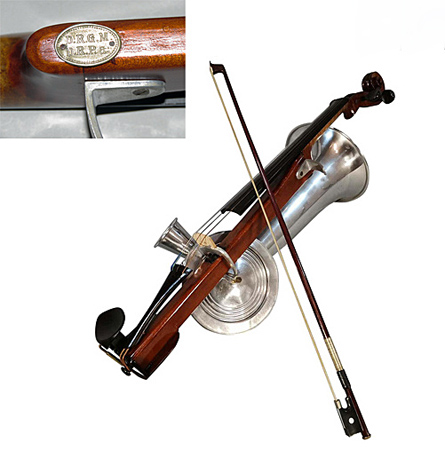
Owner: HWMC
Catalog#: 2CL-CHLT-112
Violin Family
Willy Tiebel ‘Violine’ (A)
Markneukirchen, Germany
Willy Tiebel
Wood, metal
ca. 1920’s
Length: 23.5 inches
Strings – Lutes – Violin Family
This rare Tiebel violin or horn violin (referenced as: ‘resophonic double horn violin’) is like a stroh viol. It was made around 1920’s by Willy Tiebel, in Markneukirchen, Germany; a town in the Vogtlandkreis district, of Saxony, Germany, close to the Czech border. These violins do not have a wooden sound box but a large diaphragm and were often used for sound recordings. Attached is a small metal plate that reads: D.R.G.M., which stands for: Deutsches Reich Gebrauchsmuster, and D.R.P.a. which stands for Deutsches Reicjspatent angemelded.
The Stroh viol, after which this Tiebel horn violin is modeled, was patented (English Patent #9418) by John Matthias Augustus Stroh in London England on May 4, 1899. Stroh was born in Frankfurt am Main in 1828, and was an apprentice watch and clock maker, who immigrated to England in 1851. He invented many acoustical devices, including the first gramophone to be demonstrated in Britain. Thus, the concept of this violin patent originated from work on the mechanical sound box of the gramophone. Later, in 1901 (UK patent 3393), he patented an aluminum conical diaphragm for it as well as for phonographs and other analogous sound producing, recording, or transmitting devices.
Another important feature he added soon after its invention was a small horn attached to the larger horn or to the diaphragm, so that the violinist might hear themselves better when playing with louder instruments such as brass instruments. Stroh instruments included horned violas, cellos, mandolins, guitars, and ukuleles as well as the violin and were manufactured in London first by his son Charles in 1901, then by George Evans & Co. from 1904-1942.
